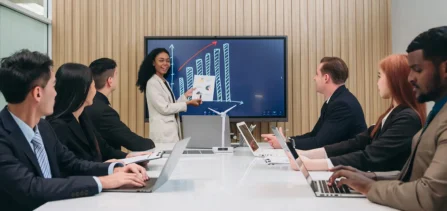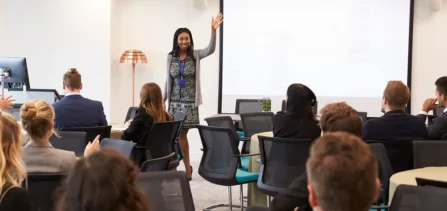
Q&A Techniques for a Perfect Question and Answer Session
How to run ‘part two’ of your presentation for maximum audience engagement
Learn These Q&A Techniques for the Perfect Informal Question and Answer Session
There are many presentation techniques that enhance the value of your Q&A sessions, but the most important is to treat them as part two of your presentation and prepare as much as possible.
If part one is the formal delivery using speaker-support slides, then the Q&A is an informal follow-up session in which further content is delivered in the form of answers to questions. For example, clarifying points, going into further detail, and alleviating any concerns.
With that in mind, here are our top ten presentation techniques for preparing and hosting a perfect Q&A.
How to run ‘part two’ of your presentation for maximum audience engagement
Give Advance Warning
A Q&A session with no questions can feel a little awkward, but there are presentation techniques you can use to encourage interaction. For example, if you provide advance warning of a Q&A session at the start of your presentation, then it encourages the audience to make mental notes about things they could ask.
Another presentation technique is to kick off the Q&A session by asking “Who has the first question?” This creates an expectation that there are questions out there and can encourage someone to put their hand up.
Treat Questions Equally
Avoid saying “Good question” as it infers you are grading audience members on the quality of their input. This can stifle questions from those who have more basic queries about something they didn’t quite understand. If they leave the room without clarification, then your presentation may not have achieved its objective.
Make it clear that all questions are welcome. If one really stands out, simply say “Thank you for asking that question.”
Repeat the Question for Everyone
Look at the person as they ask their question and then repeat it back the question to the whole room so everyone has the necessary context for your answer. This also gives the impression that the question was asked by the whole audience and provides an opportunity for the originator of the question to correct you if you misheard or misunderstood.
Before you answer, don’t forget to use another important presentation training technique – the well-timed pause.
Answer Questions to the Room
One of the most important presentation techniques is to address the entire audience with your answer so everyone benefits from the information. Equally, avoid the temptation to move towards the person who asked it. Continue to stand where you are so everyone in the audience feels equal.
Eye contact is another essential skill to learn. Check out our presentation tips on how to use the power of eye contact to enhance audience engagement.
Give Concise Answers
Lengthy responses can make the audience feel like they are back in the formal part of the presentation again. Always deliver answers as concisely as possible, but with enough detail to ensure everyone understands.
Bear in mind that the person asking the question may be the only one who wants to hear the answer. If you feel someone would benefit from further information, then suggest they come and see you after the Q&A.
Check Your Response
After delivering an answer, ask if it was satisfactory. This confirms you helped the person who asked the question and provides an opportunity for a follow-on question if time allows. However, never allow more than two questions in a row so the Q&A session remains a fair and balanced opportunity for everyone.
Kick Off with a Question Yourself
If no one has any questions, it can help to prepare a few of your own to get the ball rolling. For example, you could say:
“A question I’m often asked is…”
or
“You might be asking yourselves…”
Answer your own question, and then open the floor to others again. You can even strategically word your answer to raise a logical follow-on question.
Kicking off the Q&A session yourself shows you have passion for the subject, which is one of the seven laws of presentation skills.
Answering Loaded Questions
Loaded questions are one of the toughest challenges of Q&A sessions, but some simple presentation techniques can prevent them from derailing you or undermining your confidence.
The purpose of a loaded question is often to corner you into a specific answer that makes you look incorrect, morally wrong, or simply unprofessional. The person asking the question often has an agenda, and their aim may be to discredit you or what you are saying.
One of the best presentation techniques for this situation is to defuse the question first. For example, if someone asks
“What are you doing with all the money you make from the price increase?”
You could defuse it by saying that you understand their frustration. Then rephrase their question into a less emotionally charged format such as
“I believe what you’re asking is: why such a sudden price increase?”
If the person is unsatisfied with your rephrasing, it may be better to ask them to come and talk to you after the Q&A so you can address their concerns directly.
If a loaded question is off-topic, then don’t be afraid to politely say
“Actually, that question doesn’t quite fit the context of this discussion.”
Dealing With Speech Makers
Sometimes the person asking the question simply wishes to make a point. This is okay for short points, and you can simply thank them for their comment and move on to the next question.
Occasionally, you may encounter someone who wishes to make a speech themselves, but this is unfair to those who have genuine questions.
Presentation techniques for this situation include waiting for the speechmaker to pause or take a breath, and then interrupting with
“Thank you very much for your comment. Next question?”
Then quickly look to the other side of the room and point to the next person with a question. In most cases, the speech maker will be unsure whether you interrupted them deliberately or genuinely thought they had finished.
Prepare, But Be Prepared to Say “I Don’t Know”
Take time to prepare for both parts of your presentation. For the Q&A session, look at the content of your formal delivery and think about the questions it might raise. If your presentation feels comprehensive, it can even be useful to reduce the level of detail in one or two sections to make them logical areas to explore in the question & answer session.
Once you have anticipated questions, prepare concise answers but never use notes or slides to deliver them as you don’t want it to seem rehearsed. The audience may even think the person asking the question was planted by you.
Finally, it is perfectly acceptable to say that you don’t know the answer. Feel free to provide a useful opinion, but make sure the audience knows you are unsure. Alternatively, simply note down the question and say you will follow up with an answer.
If you have any anxieties about answering questions, we have many other presentation techniques to help you.
This article was originally contributed by Stephen D. Boyd
Question and Answer Techniques
Impact Factory runs
Open Presentation Skills Courses
Tailored Presentation Training
Five-Day Immersive Presentation With Impact Workshops
and personalised
One-to-One Presentation Coaching
for anyone who is interested in



